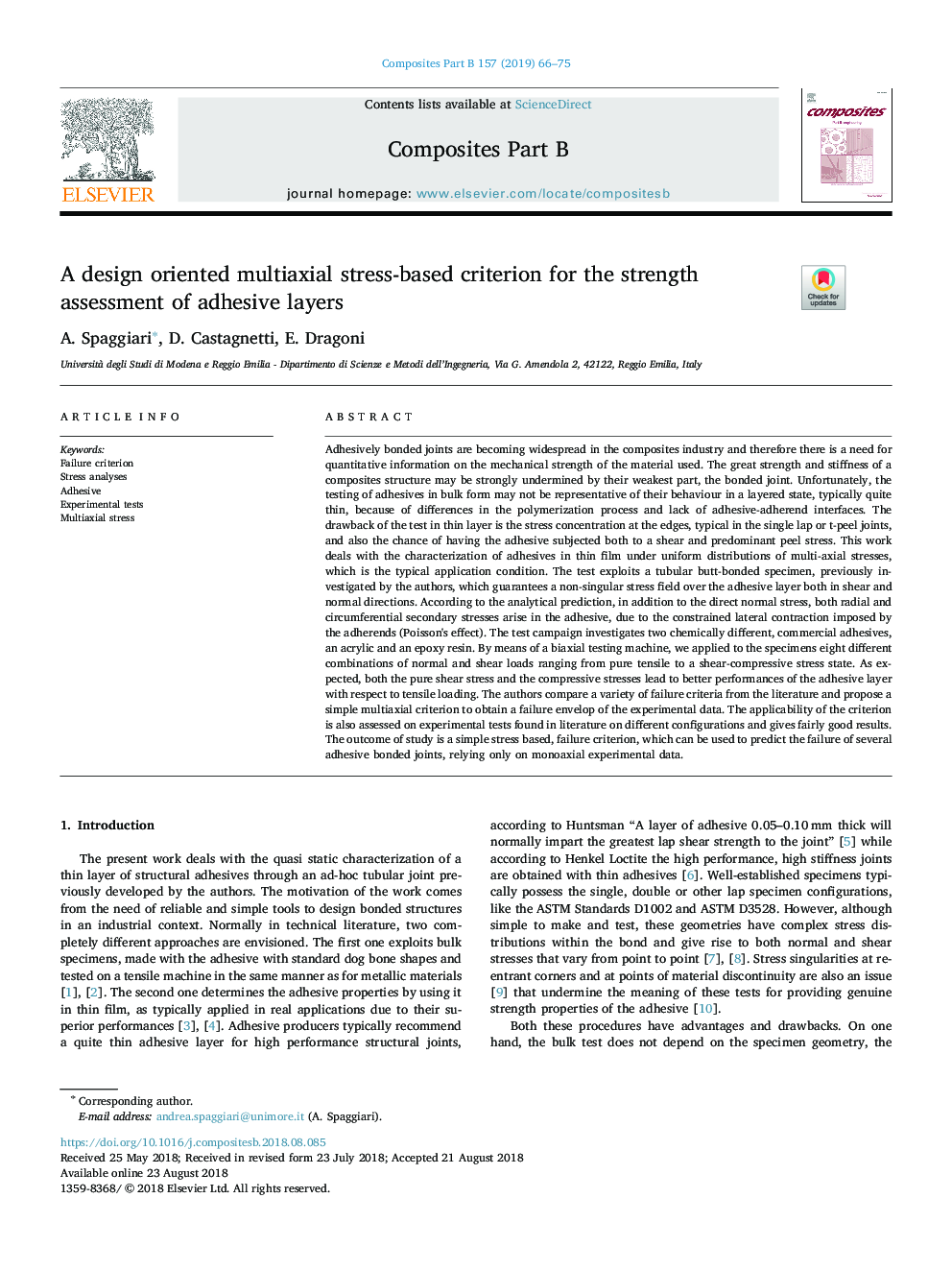| کد مقاله | کد نشریه | سال انتشار | مقاله انگلیسی | نسخه تمام متن |
|---|---|---|---|---|
| 8954476 | 1646004 | 2019 | 10 صفحه PDF | دانلود رایگان |
عنوان انگلیسی مقاله ISI
A design oriented multiaxial stress-based criterion for the strength assessment of adhesive layers
ترجمه فارسی عنوان
معیار ارزیابی استحکام چند محوری طراحی شده برای ارزیابی قدرت لایه های چسب
دانلود مقاله + سفارش ترجمه
دانلود مقاله ISI انگلیسی
رایگان برای ایرانیان
کلمات کلیدی
معیشت شکست تجزیه و تحلیل استرس، چسب، آزمایش های تجربی، استرس چندضلعی،
ترجمه چکیده
اتصالات چسبنده اتصال در صنعت کامپوزیت ها گسترده می شود و بنابراین نیاز به اطلاعات کمی در مورد مقاومت مکانیکی مواد مورد استفاده وجود دارد. قدرت و استحکام عالی ساختار کامپوزیت ها می تواند به شدت تحت تأثیر ضعیف ترین قسمت، مفصل باند قرار بگیرد. متاسفانه، آزمایش چسب ها به صورت فله ممکن است نمایانگر رفتار آنها در حالت لایه ای باشد، به طور معمول کاملا نازک است، به دلیل تفاوت در روند پلیمریزاسیون و عدم وجود رابط چسبنده. ضعف آزمایش در لایه نازک، تمرکز استرس در لبه ها است که معمولا در مفاصل تک یا مچ پا وجود دارد، و همچنین احتمال وجود چسب در هر دو جهت برش و تنش پوستی غالب وجود دارد. این کار با مشخص کردن چسب در فیلم ناز تحت توزیع یکنواخت تنش های چند محوری است که شرایط نرمال است. آزمایش با استفاده از یک نمونه مهره ای لوله ای که قبلا توسط نویسندگان مورد بررسی قرار گرفته است، از نظر تنش غیر منحصر به فرد بیش از لایه چسب هر دو در جهت برشی و نرمال تضمین می کند. با توجه به پیش بینی تحلیلی، علاوه بر تنش مستقیم مستقیم، فشارهای ثانویه رادیال و محدوده ای در چسب نیز بوجود می آیند، به دلیل انقباض جانبی جانبی محدود شده که توسط پیوست ها (اثر پواسون) تحمیل می شود. کمپین آزمایشی دو چسبندگی شیمیایی مختلف، چسب های تجاری، یک اکریلیک و رزین اپوکسی را بررسی می کند. با استفاده از دستگاه تست دو طرفه، ما به نمونه های هشت ترکیب مختلف بارهای نرمال و برشی اعم از کششی خالص به حالت استرس برشی - فشاری اعمال کردیم. همانطور که انتظار می رود، هر دو تنش برشی خالص و تنش فشاری منجر به عملکرد بهتر لایه چسب با توجه به بار کششی. نویسندگان مقیاس های مختلف شکست را از ادبیات مقایسه می کنند و یک معیار چند ضلعی ساده را برای به دست آوردن یک پوشش شکست از داده های تجربی پیشنهاد می کنند. کاربرد معیار نیز بر روی آزمایش های تجربی موجود در ادبیات مربوط به پیکره بندی های مختلف ارزیابی می شود و نتایج نسبتا خوبی را به دست می دهد. نتیجه مطالعه یک استرس ساده مبتنی بر معیار شکست است، که می تواند مورد استفاده قرار گیرد برای پیش بینی شکست چندین اتصال چسبنده، با تکیه بر تنها در داده های تجربی یکپارچه.
موضوعات مرتبط
مهندسی و علوم پایه
سایر رشته های مهندسی
مهندسی (عمومی)
چکیده انگلیسی
Adhesively bonded joints are becoming widespread in the composites industry and therefore there is a need for quantitative information on the mechanical strength of the material used. The great strength and stiffness of a composites structure may be strongly undermined by their weakest part, the bonded joint. Unfortunately, the testing of adhesives in bulk form may not be representative of their behaviour in a layered state, typically quite thin, because of differences in the polymerization process and lack of adhesive-adherend interfaces. The drawback of the test in thin layer is the stress concentration at the edges, typical in the single lap or t-peel joints, and also the chance of having the adhesive subjected both to a shear and predominant peel stress. This work deals with the characterization of adhesives in thin film under uniform distributions of multi-axial stresses, which is the typical application condition. The test exploits a tubular butt-bonded specimen, previously investigated by the authors, which guarantees a non-singular stress field over the adhesive layer both in shear and normal directions. According to the analytical prediction, in addition to the direct normal stress, both radial and circumferential secondary stresses arise in the adhesive, due to the constrained lateral contraction imposed by the adherends (Poisson's effect). The test campaign investigates two chemically different, commercial adhesives, an acrylic and an epoxy resin. By means of a biaxial testing machine, we applied to the specimens eight different combinations of normal and shear loads ranging from pure tensile to a shear-compressive stress state. As expected, both the pure shear stress and the compressive stresses lead to better performances of the adhesive layer with respect to tensile loading. The authors compare a variety of failure criteria from the literature and propose a simple multiaxial criterion to obtain a failure envelop of the experimental data. The applicability of the criterion is also assessed on experimental tests found in literature on different configurations and gives fairly good results. The outcome of study is a simple stress based, failure criterion, which can be used to predict the failure of several adhesive bonded joints, relying only on monoaxial experimental data.
ناشر
Database: Elsevier - ScienceDirect (ساینس دایرکت)
Journal: Composites Part B: Engineering - Volume 157, 15 January 2019, Pages 66-75
Journal: Composites Part B: Engineering - Volume 157, 15 January 2019, Pages 66-75
نویسندگان
A. Spaggiari, D. Castagnetti, E. Dragoni,
